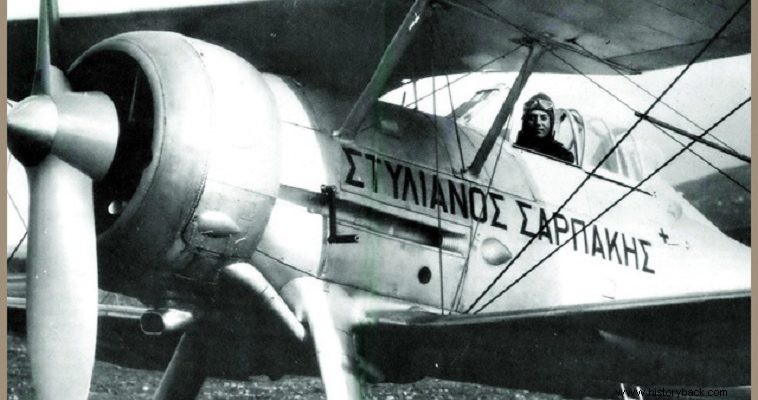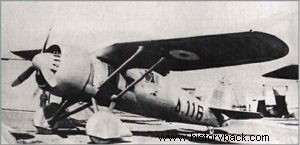
In 1935, the Hellenic Air Force essentially did not exist. It had the Gloster Mars VI Nighthawks, built in 1919, with a maximum speed of 193 km/h and armed with two 7.7 mm Vickers machine guns as the main pursuers. These aircraft were completely incapable not only of operating, but even of flying, due to their age.
With the outbreak of the pro-Venezuelan coup, in March 1935, 5 Czechoslovak Avia BH-33H double-winged fighter jets, also armed with two light machine guns and with a maximum speed of 315 km/h, were purchased from Yugoslavia.
On August 18, 1936, the rich expatriate Koutarelis bought two Czechoslovak Avia B534 fighters, which he donated to the Air Force. The light aircraft were also close by, but had a closed cockpit, were armed with four light machine guns and a speed of 400 km per hour.
In 1937 Egyptian businessman Stylianos Sarpakis donated to the Air Force two British-built Gloster Gladiator Mk I side-by-side fighters, which also carried four light machine guns and had a top speed of 407 km per hour.
These four, in total, chasers, were the only relatively modern aircraft that the Air Force had. It was obvious that, as the clouds of war were gathering in Europe, the Greek air force needed reinforcement.
So it was decided to purchase new aircraft immediately. Greece asked to buy fighter jets from the major European powers. But he didn't succeed, as they either asked for cash payment, or didn't even sell aircraft, as they strengthened their own air forces.
So Greece turned to Poland, which had the PZL-24 fighter for sale. The purchase of 36 PZL-24 F and G aircraft was agreed. The first carried two 20mm guns. and two machine guns, while the second ones carried four machine guns.
The PZL-24 was the improved version of the Polish PZL-11 fighter and could develop a maximum speed of 430 km per hour. 12 Bloch MB-151 fighters were ordered from France, but only nine arrived in Greece.
These aircraft were modern monoplanes, with a maximum speed of 520 km per hour, armed with two 20 mm cannons. and two machine guns. However, the aircraft was still in the development phase and presented many technical problems.
However, the air force also lacked bombers. So it was decided to purchase 24 of the excellent British Bristol Blenheim Mk IV light bombers. However, the British stated that they could only dispose of 12 and so, in place of the undelivered 12, the also British Fairey Battle B1 light bombers were purchased.
12 Avro Anson Mk I multi-role aircraft were also purchased, which took over surveillance of the Aegean. 24 French Potez 633 light bombers were also purchased, but ultimately 11 were delivered.
Also purchased were 16 German Henschel Hs126A-1 military cooperation aircraft and 12 German Dornier Do 22kg naval cooperation seaplanes, but these were eventually used as military cooperation aircraft, replacing the wheeled floats.
Finally, a number of Avro 621 Tutors and Avro 626 trainers were also purchased, which were used in the 1940-41 operations as identifiers.
Thus the air force, from scratch, found itself with 45 new fighters, 35 bombers and another 12 aircraft capable of carrying out bombing missions and 28 aircraft of military and naval cooperation, i.e. a total of 120 front-line aircraft.
Added to these were the few serviceable Brequet 19 A2/B2 military cooperation aircraft purchased in the late 1920s and early 1930s and the Potez 25 TOEs. Thus the non-existent, essentially air force, took on flesh and bones and achieved feats over the northern continental front and beyond.
The Greek fighter squadrons, which during the war were reinforced by at least 14 Gloster Gladiators, which the British provided in late 1940, achieved, according to some sources, at least 34 confirmed downs and 24 possible, lost, in the air , 19 aircraft.
Some sources speak of 64 downs. The best Greek pilots who emerged at that time were Squadron Leader A. Antoniou, commander of the 22nd Pursuit Squadron, with 5 and 1/2 confirmed downings (he achieved the "half shooting down" in collaboration with another pilot), Squadron Leader I. Kellas, commander of the 21st Prosecution Squadron, with 3 and 1/3 downed, the officer E. Dagoulas with 2, confirmed and 2 possible, G. Fanourgakis with 1 confirmed and 3 possible downed and M. Mitralexis with 1 confirmed and one possible.



